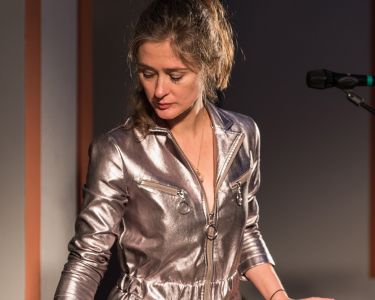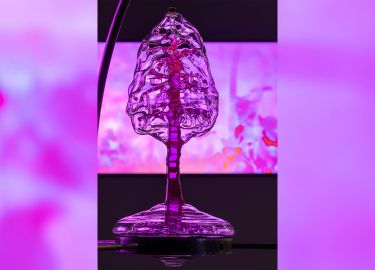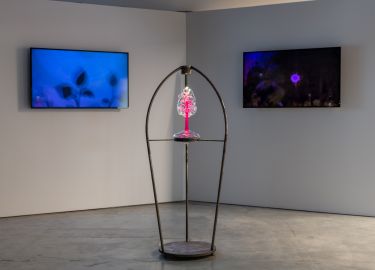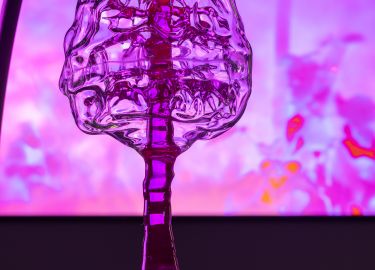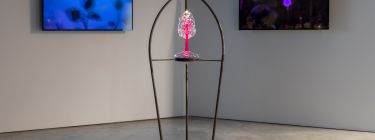
Stranger To The Trees
Artist in Residence at the Faculty of Maths and Physical Sciences, University College London & Fellow of the Royal Society of Arts

STranger to the trees
Hybrid art uncovering a new materiality in our world, for crisis or awakening…
The Green Transition of our society is urgent and will drive the renewal of cities and economy alike, as we overcome the Covid-19 pandemic. However, to move beyond our current relationship with what is casually called “the environment”, we must in fact reconfigure the understanding of humankind’s influence on the planet.
Stranger To The Trees (STTT) is a transdisciplinary art-led project that sheds light through a hybrid artistic form on the invisible but harsh reality of how microplastics are changing the materiality of the world. The work steps outside of the human perspective by focussing on the possibility of coexistence between microplastics and trees. In so doing, the work addresses a fundamental necessity—that of moving beyond a human-centric view to achieve a more-than-human understanding of the echoes of human activity.
STTT is a multimedia, interactive installation that combines sound, sculpture and video, alongside a scientific publication (Austen, 2022). A combination of these forms of output sheds light conceptually, factually and emotionally on the possibilities and meanings of microplastics and birch trees coexisting in the time of the climate crisis.
Microplastics are a ubiquitous and irrevocable anthropogenic new material dispersed throughout the environment reaching the furthest and wildest crannies of the planet. Particles of plastic have been found in the clouds, on top of the tallest mountains and in the deepest ocean trenches. This artificial material represents the uncompromising impact of human activity on the planet and has already been observed to be an evolutionary prompt for microorganisms. Furthermore, microplastics’ presence is an embodiment of our addiction to the extraction of fossil fuels, or as they should properly be named, long carbon reserves.
We cannot call back these tiny fractionations of humanity’s exploitative industrial legacy. They persist even beyond our reaches, changing the materiality of the world and the entities within it, even ourselves. What we can do is to reconfigure our understanding of the consequences of this undeniable reality. The artwork Stranger to the Trees addresses this issue through the lens of coexistence. The work realises in hybrid artistic form the new materiality of the entanglement of forests and plastic pollution.

The project was driven by a motivation to understand the stark reality of microplastic pollution from a more-than-human perspective. Central to the concept is the fact that plastic pollution is, like forests, itself a carbon sink. In the context of fossil fuel extraction and the carbon cycle, the question arises of whether microplastic interaction with trees might, beyond the instinctive horror of artifice pervading nature, carry another meaning. The research for the project, which is still ongoing in the form of a long-term experiment, mixes artistic and scientific methods to explore how birch, a pioneer tree species, and microplastic particles interact.
Stranger to the Trees successfully melds DIY and traditional scientific research with artistic research and production. The diverse outputs, each impactful in its own way, together provide access to a new understanding of what we perceive as nature. The project showcases a modality by which to develop the aesthetic, cognitive and embodied knowledge needed in order to move towards a more just, resilient future in which humans cooperate with those entities with which we share the planet.
References
Austen, K, Maclean, J, Balanzategui, D and Hölker, F, “Microplastic inclusion in birch tree roots”, Science of the Total Environment, 808 (2022) 152085 https://doi.org/10.1016/j.scitotenv.2021.152085
More info: https://www.katausten.com/portfolio/stranger-to-the-trees/
Other partners involved (think of artists/ producers/ industry/ science collaborators): STTT is realised within the framework of the European Media Art Platforms EMARE program at WRO Art Center with support of the Creative Europe Culture Programme of the European Union
All Photos: Copyright by Andreas Baudisch
Kat Austen
Kat Austen is a person. In her artistic practice, she focusses on environ-mental issues. She melds disciplines and media, creating sculptural and new media installations, performances and participatory work. Austen’s practice is underpinned by extensive research and theory, and driven by a motivation to explore how to move towards a more socially and environmentally just future. Working from her studio in Berlin, Austen is currently Artist in Residence at the Faculty of Maths and Physical Sciences, University College London, Senior Teaching Fellow at UCL Arts and Sciences and Associate Artist Fellow at Institute for Advanced Sustainability Studies, Potsdam. Her studio hosts two Scientists in Residence through the STUDIOTOPIA programme hosted by Ars Electronica. She is a Fellow of the Royal Society of Arts. Austen was Artist in the Arctic 2017 for Friends of Scott Polar Research Institute (University of Cambridge) for her project The Matter of the Soul. In 2018 Austen was selected as inaugural Cultural Fellow in Art and Science at the Cultural Institute, University of Leeds for the same project. Austen has been awarded residencies internationally, including EMAP / EMARE Artist in Residence at WRO Art Center, AiR at NYU Shanghai, ArtOxygen Mumbai and LAStheatre.
Picture: © Andreas Baudisch
